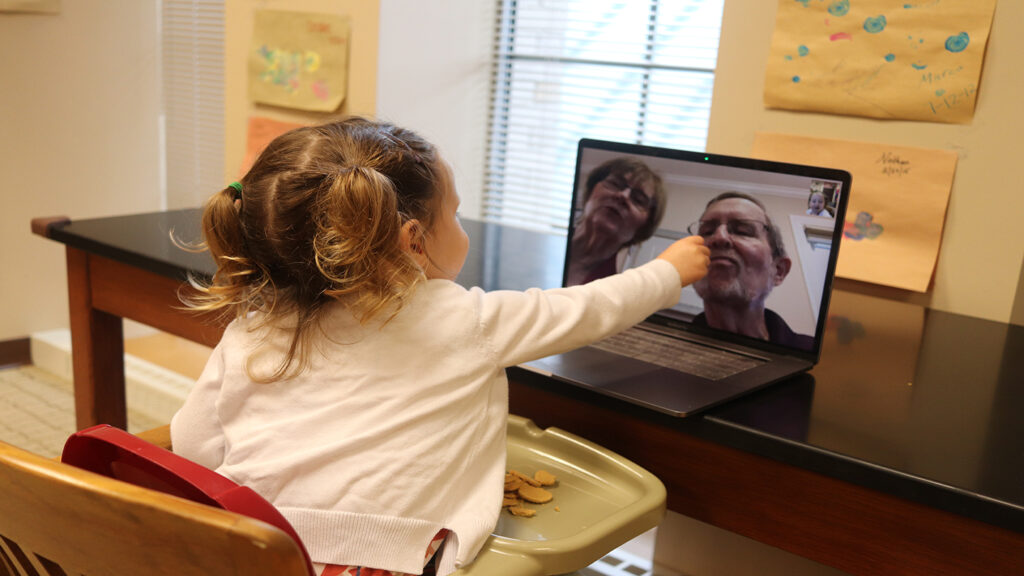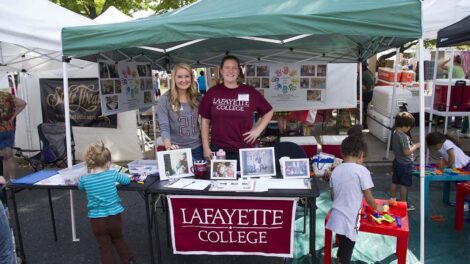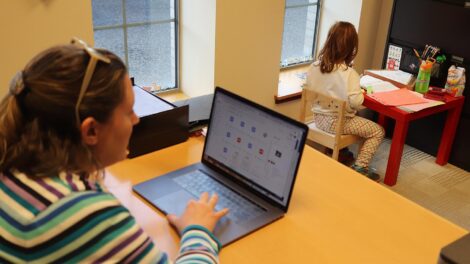Prof. Lauren Myers’ collaborative research investigates technology building grandchild-grandparent connections
By Shannon Sigafoos
Throughout the past year, video chat has helped to mitigate the potential negative impacts of forced separation and reduced in-person contact between grandparents and grandchildren. In the future, it also may prove to be a supportive first step in children using and understanding technology, according to research by Lauren Myers, associate professor of psychology, and her field colleagues.

Lauren Myers
By using an ecological model framework to examine factors associated with the development of the grandparent–grandchild relationship during the COVID-19 pandemic, when many families were experiencing reduced opportunities for in-person interaction, the group found that the frequency of video chats and the variety of behaviors engaged in during those chats predicted grandparents’ feelings of closeness to their grandchild and the whole family’s enjoyment of video chats.
The study, the first of its kind and soon to be published in a special issue of the journal Human Behavior and Emerging Technologies, revealed that while much attention has been focused on the impact of the pandemic on schooling, the economy, health disparities, and the public’s view of science, relatively little attention was paid to the impact of the pandemic on the family system—particularly the relationships between grandparents and grandchildren.
With parents seen as the middle generation support piece, grandparents and grandchildren may grow closer as children develop social capacities (such as joint attention) and linguistic abilities, allowing grandchildren to participate in more mutually responsive, reciprocal interactions with their grandparents via video chat technologies such as Zoom, FaceTime, Skype, and other platforms.

The young daughter of Prof. Lauren Myers reacts to her grandparents during a video chat.
Myers worked with a team of colleagues who all work in psychology and human development at colleges and universities across the country, as well as in research at the LEGO Foundation’s Centre for Creativity, Play, and Learning. Myers said they initially discussed how at the start of the pandemic, it became clear that grandparents and grandchildren may be separated for a substantial amount of time. Everyone in the group had done prior research on children’s cognitive development and associated screen time, and the pandemic opened the door to research on how video chat had become such a stable mode of communication.
“We were all in places, individually, where none of us could have done this study on our own,” says Myers. “But, we knew we had to jump on this unique moment in time, and we thought if we could work together, we could really do something interesting. We pooled our resources to form a ‘dream team’ and put out this big survey for grandparents and parents last summer, and Tier 1 of that data is what this published research is about.”
The group utilized Children Helping Science and partnered with the American Association of Retired Persons (AARP)—which also helped fund the project—to find participants. They also posted online advertisements in places hit hard by the pandemic.
For their first report, the team analyzed demographic variables, the percent of grandparents and parents reporting (technical or social/emotional) barriers to video chat usage, activities (such as smiling or waving) that grandparents participate in during each video chat, and the percent of parents reporting they engage in each activity during grandparent–grandchild video chats.
Future tiers of data will analyze results from a subset of participants who are sending the research team their video chat recordings at different time points, including when babies are 3 months old and then again every couple months, as the pandemic-era babies approach their first birthdays.
“We’re kind of getting to the end of when we’re getting the data from participants, and then after we get the data, there’s a bunch of processing, and we have coding systems we go through that quantify what the parents are doing and what the kids are doing,” says Myers. “Hopefully over the years, we’re going to have several projects from this because we’ve gotten a lot of data.”
The research team Myers worked with included Gabrielle Strouse (Division of Counseling and Psychology in Education, Center for Brain and Behavior Research, University of South Dakota), Elisabeth McClure (The LEGO Foundation, Denmark), Jennifer Zosh (Department of Human Development and Family Studies, Pennsylvania State University), Georgene Troseth (Department of Psychology and Human Development, Vanderbilt University), Olivia Blanchfield (Department of Psychology, Georgetown University), Ellen Roche (Department of Psychology, Georgetown University), Subul Malik (Department of Psychology, Georgetown University), and Rachel Barr (Department of Psychology, Georgetown University).
Research group publishes with AARP and ZERO TO THREE
Myers and several of her colleagues also have recently published other research pertaining to the usage of video chat. In a report for AARP, they reported that video chat helped grandparents overcome social isolation during the pandemic, as well as maintain a vital connection with their young grandchildren.
A separate professional resource for ZERO TO THREE utilized more than a decade of research to discover how young children learn and connect via video chat, and applied that information to demonstrate how families and educators may navigate relationship building and learning during periods of separation, including the pandemic.




1 Comment
I have also been video chatting with my grandparents since they live abroad. It has been very effective as I tell them about my life. I also told them during a video call about how I have been waitlisted from Lafayette and how desperate am I to become a Leopard.
Comments are closed.